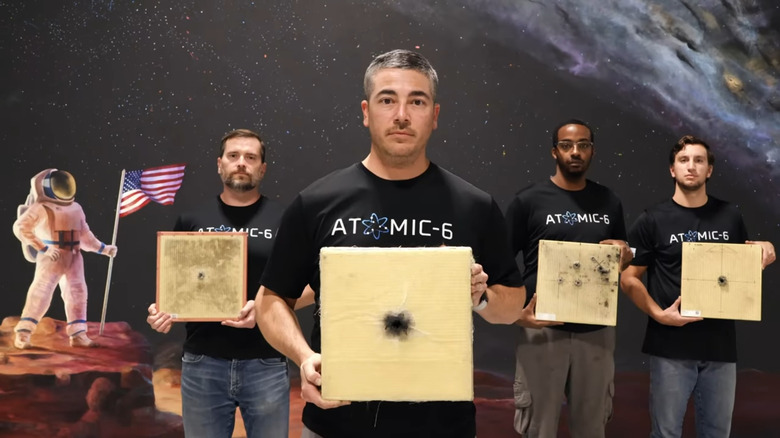This New Space Armor Could Save Astronauts From Deadly Space Debris
You might not expect there to be much risk of collisions out in the infinite void of space, but at least within Earth's orbit, there's a veritable gravel pit of loose debris flying around at potentially dangerous speeds. Earth's space junk problem is pretty concerning, what with the well over million pieces of debris in orbit, and that's just the bits large enough to track. This is why composite materials manufacturer Atomic-6 has developed its new "Space Armor," a lightweight, high-strength material that could protect spacecraft, satellites, and even astronauts themselves from these spacebound projectiles.
Unlike here on Earth, there's no gravity to slow a projectile's momentum in space, so once a little shard of metal gets up to speed, it won't stop until it hits something with disastrous results. Space Armor is designed to safely receive the impact of flying space debris without endangering sensitive equipment beneath the plating, or allowing any other debris to penetrate or splinter off into additional projectiles. Not only will this armor plating go a long way toward protecting vital spacefaring assets and personnel, it can do so with a fraction of the weight of most leading protection solutions.
Space Armor has impressive strength at lighter weights
Currently, the most frequent choices for protecting spacecraft are materials like solid aluminum and the Whipple Shielding employed by some satellites and the International Space Station. While these materials are good enough at stopping the majority of direct impact damage, their metal compositions mean that, when struck, small bits will splinter off and go flying, which leads to more debris orbiting around Earth and potentially transforming into more dangerous projectiles. Researchers have been tinkering with ways to cut down on space debris, such as Japan's experiments in building satellites out of wood, but we still need a better way to protect what's already up there.
Space Armor is made of a composite material rather than metal, which means that when it's struck, it doesn't generate any additional debris. The material is also far lighter than its metal contemporaries while providing the same level of strength and coverage. A square meter of Space Armor Lite tile weighs about 14 kilograms (approximately 30.8 pounds), and can stop a projectile up to 3 millimeters in size flying at up to 7.2 kilometers per second. You'd get roughly the same basic strength and size defense from a sheet of aluminum with a thickness of 1 centimeter, but that aluminum sheet would weigh twice as much at 28.8 kilograms (approximately 63.5 pounds).
Atomic-6 is currently developing an even stronger Space Armor plate, Space Armor Max, with comparable stopping power to Whipple Shielding. The company doesn't know exactly how much it will weigh yet, but odds are good it will be less than the 27.5 kilograms you'd get from a square meter of Whipple Shielding.
The plates could protect spacecraft, satellites, and astronauts
Atomic-6 developed Space Armor plating with the help of funding from the U.S. Air Force and U.S. Space Force, specifically a $1.2 million Small Business Innovation Research Phase 2 award and a $3.8 million Tactical Funding Increase agreement. With the blessing of both agencies, Atomic-6 is looking to begin running tests in orbit with satellites as soon as next year.
Atomic-6 has already conducted extensive testing using simulated hypervelocity launchers, which fire off small projectiles at a comparable speed and size to the flying debris that spacecraft could be subjected to. Part of the appeal of Space Armor's tile-based design is that the tiles can be sized and cut to a client's needs, with custom sizing up to 1 square meter available.
"It has taken around 18 months to take Space Armor tiles from an idea to a final product. So we took the shot at making a tile, and were blown away by the test results," Atomic-6 CEO Trevor Smith said in a statement to Space.com, "We offer Space Armor in simple hex tiles, but we can technically make Space Armor into most any shape you want."
Once Space Armor's viability has been definitively proven, it could be used in just about any spacefaring applications you could think of, whether it's protecting vital communication satellites, shoring up space craft, and even providing an extra layer of defense to astronauts. For satellites in particular, Space Armor comes in both radio-permitting and radio-blocking versions, unlike Whipple Shielding which blocks all radio signals. The tiles could be used to protect the most sensitive parts of a communication satellite without hampering its functions. This kind of benefit will become even more important as more satellites are sent into orbit from brands like Starlink.

